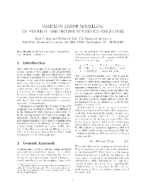
An official website of the United States government
Here’s how you know
Official websites use .gov
A .gov website belongs to an official government organization in the United States.
Secure .gov websites use HTTPS
A lock (
) or https:// means you’ve safely connected to the .gov website. Share sensitive information only on official, secure websites.
-
//
- Census.gov /
- Library /
- Census Working Papers /
- Sampling Error Modelling of Poverty and Income Statistics for States
Sampling Error Modelling of Poverty and Income Statistics for States
Sampling Error Modelling of Poverty and Income Statistics for States
Introduction
This paper develops models for sampling error covariance matrices of estimates of age group poverty rates, median income, and per capita income from the Current Population Survey's (CPS) March Supplement. (Not part of the normal CPS estimation procedures, the covariances for 1989 to 1993 were estimated by Bob Fay using vplex , a variance estimation program (Fay 1989). The ultimate objective is to use the sampling error models developed here, in combination with models for the time series of poverty rates and income measures, to improve estimates of the “true" (unobserved) state poverty rates and income measures.
Our models account for three features of the CPS sampling error covariance structure: (1) differences in the variances by state (through random state effects): (2) dependence of variances on sample size and on the level of the estimates (through a generalized variance function, GVF); and (3) sampling error correlations over time (through an autoregressive-moving-average (ARMA) time series model). Section 2 describes our general modelling approach. Then, in Section 3, we discuss details of the model development for the CPS application.
Share
Related Information
Some content on this site is available in several different electronic formats. Some of the files may require a plug-in or additional software to view.
 Yes
Yes
 No
NoComments or suggestions?


Top


